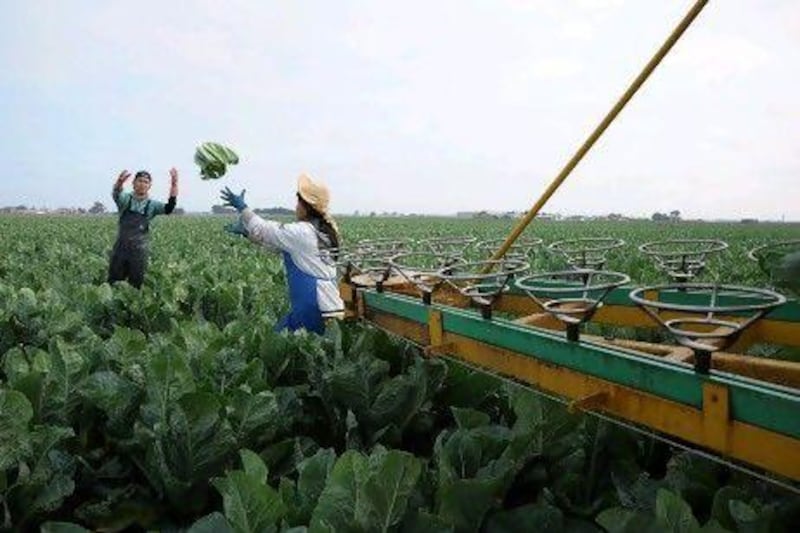CANBERRA // Australia's government has issued its first major Asian strategy paper in more than two decades, aimed at cashing in on the "Asian Century".
Focusing on improving skills, infrastructure, productivity and business, "Australia in the Asian Century" also warns of the growing potential for conflict over territorial claims among the increasingly affluent and confident nations of the region.
"The scale and pace of Asia's transformation is unprecedented and the implications for Australia are profound," says the paper prepared by a team headed by former Treasury Department chief Ken Henry.
It highlights Australia's delicate balancing act between critical, mainly commodities, markets such as China and the Canberra government's main military ally, the United States.
The US is using Australia to boost its force projection in Asia under a new policy of boots on the ground announced a year ago by US President Barack Obama and Australian prime minister Julia Gillard.
"It's not enough to rely on luck - our future will be determined by the choices we make and how we engage with the region we are engaged in," Ms Gillard, the leader of the minority Labor government, said in releasing the Henry report.
"We must build on our strengths and take active steps to shape our future."
But "Australia in the Asian Century" comes amid strong opposition to Asian investment, particularly in rural Australia where there is mounting anger at foreign buy-ups of prime farming lands, including vital and expensive irrigation rights to limited water supplies on a dry continent.
Many of Australia's family farms are dying. Many are almost bankrupt. But there is a deep-rooted resistance to the international investment needed to revive them.
Polls show four out of five Australians oppose "selling the farm" to foreign investors.
"I may go under," says Peter, a second-generation rice farmer in the rich irrigation belt along the border of southern New South Wales and northern Victoria. "But I want my land to stay Australian."
Australia's ANZ Banking Group estimates the country needs to invest 1 trillion Australian dollars (Dh3.8 trillion) over the next 40 years to improve production and delivery.
The new report, or White Paper, adds little to the last Asian White Paper produced in 1989 under an earlier Labor government.
"If you've been awake and paying attention, there's nothing much in the paper that should surprise you, but the vast majority of Australians really have no idea of just how big Asia is already, let alone what it's becoming," said newspaper and TV commentator Michael Pascoe.
White Papers are a broad outline of government policy that may be further refined and many of their measures still require parliamentary approval before they can be implemented.
"What's new in this one?" asked a senior Australian foreign department official. "We've been hearing this from both sides of the fence [government and opposition] for as long as I have been doing this," she said.
The 1989 paper was prepared at a time of more stability and less economic uncertainty among Australia's Asian partners.
In 1989, Indonesia's president Suharto and Malaysian prime minister Mahathir Mohamad were in firm control and China's communist leadership had just put down the Tiananmen Square revolt.
Critics say the Henry paper is aimed more at shoring up domestic support for a struggling Gillard government less than a year from elections than producing a cohesive long-term regional vision.
Its key aims - with a target year of 2025 - are raising per person income, moving Australia higher in world education rankings - foreign students are a significant income earner - making every schoolchild learn an Asian language and making it easier for foreign firms to do business here.
Despite a strong Australian dollar, demand from energy-hungry economies such as China and India have boosted Australian resource exports and underpinned one of the fastest growing-economies among industrialised nations.
The Canberra government's midyear review released last month forecast annual Gross Domestic Product (GDP) growth of three per cent, compared with about two per cent for the US.
In 1989, the then Labor prime minister Bob Hawke commissioned Australian National University academic and former ambassador to China Ross Garnaut to write a report on trade prospects in Asia, Australia and the North East Asian Ascendancy.
The Garnaut report was the first comprehensive review of Australia's relationship with Asia after the end of the White Australia Policy, a restrictive immigration programme only effectively ended in 1973.
But Australia's focus on the Garnaut report was derailed by the mid-1990s South East Asian financial crisis that destroyed export markets and political stability in the region.
The major difference between the latest report and the Garnaut report is twinning economic and military security.
"We support China's participation in the region's strategic, political and economic development," the Henry paper says.
"We will work with the United States to ensure it continues to have a strong and consistent presence in the region, with our alliance contributing to regional stability, security and peace."
The increased US military presence in Australia - including more naval visits, a permanent Marines presence in the north and pre-positioning of supplies - announced during the Obama visit - sparked a stern rebuke from China.
And the region is torn by intractable and volatile territorial disputes between the countries within the 10-member Association of South East Asian Nations, Japan, China and the Koreas.
Australia's business leaders welcomed the Henry paper, although critics say it is short on details about how exactly to achieve its aims.
But Richard Leupen, chief executive officer of engineering, rail and infrastructure company United Group and one of the country's richest businessmen, said that the white paper was "a useful start - a common sense framework for now". "We need to engage with this huge opportunity," he said





